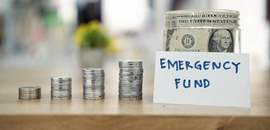

Key Takeaways
- An emergency fund is a cash reserve for urgent, unplanned events like job loss or medical bills, not for discretionary spending.
- The standard goal is to save 3-6 months of essential living expenses, adjusting the target based on job stability and dependents.
- Start with a small, achievable goal, like $1,000, to build momentum before working toward your full target.
- Keep your money in a separate, liquid account like a high-yield savings account (HYSA) for safety, accessibility, and modest growth.
- The most effective way to save is by setting up automatic transfers and accelerating progress with financial windfalls like tax refunds or bonuses.
Life is unpredictable. While you can't stop a surprise car repair or an unexpected medical bill from happening, you can control how you prepare for them. Building an emergency fund can help provide a cushion that minimizes the impact of financial setbacks and may help reduce stress. This guide will show you exactly how to build an emergency fund, step by step.
What Is an Emergency Fund & Why Is It Non-Negotiable?
An emergency fund is simply a pool of money set aside in a separate account to cover large, unplanned expenses. It’s not an investment or a fund for a planned vacation; it’s your personal financial safety net.
Think of it this way: without this cash reserve, where would the money for a sudden $1,500 expense come from? For many, the answer is high-interest credit cards or even a loan from their retirement accounts, moves that can jeopardize long-term financial well-being.
The reality is that many households are not prepared. A 2025 report from the Federal Reserve found that 63% of adults would have difficulty covering an unexpected $400 expense. An emergency fund directly addresses this vulnerability, giving you the resources to handle life’s curveballs without derailing your financial goals or adding stressful debt.
True emergencies typically fall into three categories:
- Job Loss: Covering essential living expenses while you search for new employment.
- Medical or Dental Emergencies: Paying for unexpected treatments or procedures not fully covered by insurance.
- Urgent Home or Car Repairs: Funding critical repairs like a broken furnace in winter or a necessary car transmission fix.
How Much Should You Save? Decoding the 3-to-6 Month Rule
The most common piece of conventional advice is to save three to six months' worth of essential living expenses. This range provides a solid financial cushion to navigate most emergencies, including a period of unemployment.
But what are "essential" expenses? These are the costs you absolutely must cover each month to live.
- Housing (rent/mortgage)
- Utilities (electricity, water, gas)
- Food (groceries)
- Transportation (car payment, gas, public transportation)
- Insurance Premiums (health, auto, home)
- Minimum Debt Payments (student loans, credit cards)
Notice what’s not on the list: subscriptions, dining out, entertainment, and shopping. To calculate your target, you must be honest about your needs versus your wants.
Use our Emergency Fund Calculator to estimate how much to save. Calculate Your Savings
Case Snapshot: Calculating Your Emergency Fund Target
Let's imagine a household with the following monthly essential expenses:
| Expense Category | Monthly Cost |
|---|---|
| Rent | $1,500 |
| Utilities | $250 |
| Groceries | $500 |
| Transportation (Car + Gas) | $400 |
| Insurance | $200 |
| Minimum Debt Payments | $150 |
| Total Essential Expenses | $3,000 |
Using this total, the emergency fund goal would be:
- 3-Month Goal (Minimum): $3,000 × 3 = $9,000
- 6-Month Goal (Ideal): $3,000 × 6 = $18,000
Why this matters:
Calculating a precise number transforms a vague goal into a concrete target. It provides a finish line to work toward, making the process feel more manageable.
Your personal target within the 3-to-6-month range depends on your situation:
- Aim for 6+ months if: You are the sole earner, have an unstable job or income (e.g., freelancer, commission-based), have dependents, or a chronic health condition.
- Aim for 3 months if: You have a dual-income household, a very stable job (e.g., government work), low fixed expenses, or a strong support system.
Your Step-by-Step Plan to Build Your Emergency Savings
Feeling overwhelmed by the target number? Don't be. The journey of a thousand miles begins with a single step. Here’s how to get started.
Step 1: Set a "Starter" Emergency Fund Goal
Before you aim for $18,000, aim for $500 or $1,000. This is a psychologically powerful milestone. It’s enough to cover a common car repair or an urgent care visit, providing immediate breathing room. Achieving this smaller goal builds momentum and proves that you can save.
Step 2: Open the Right Kind of Account
Your emergency savings should be liquid (easy to access) and safe (not at risk of losing value). This rules out investing it in the stock market. You should also keep it in a separate account from your daily checking to reduce the temptation to spend it.
Here are the best options:
| Account Type | Pros | Cons | Best For... |
|---|---|---|---|
| High-Yield Savings Account (HYSA) | Higher interest rate than traditional savings; FDIC insured; easy to access online. | May have minimum balance requirements; rates can fluctuate. | Most people. It offers the best blend of growth and accessibility. |
| Money Market Account (MMA) | Often has a competitive interest rate; may come with check-writing or debit card access. | May require a higher minimum deposit; can have transaction limits. | Savers who want slightly more flexible access than a typical HYSA. |
| Traditional Savings Account | Very easy to open at your local bank; FDIC insured; no market risk. | Extremely low interest rate, often near 0%. Your money loses purchasing power to inflation. | Someone who needs to open an account immediately and values convenience over growth. |
A high-yield savings account is the superior choice for nearly everyone. While the interest won't make you rich, it allows your emergency fund to grow passively and better keep pace with inflation without adding risk.
Step 3: Automate Your Savings with an Automatic Transfer
This is the most critical step. Relying on willpower to manually move money each month is a recipe for failure. Instead, pay yourself first by setting up an automatic transfer from your checking account to your emergency savings account.
Schedule the transfer to occur the day after you get paid. You won't miss money you never see. Even if you start with just $25 per week, that’s $1,300 in a year. Consistency is more important than amount. Many banking mobile apps allow you to set this up in minutes and even send automatic notifications confirming the transfer.
Step 4: Hunt for Extra Cash to Accelerate Your Fund
Once your automatic transfer is set, look for ways to make lump-sum contributions.
- Dedicate Windfalls: Commit your entire tax refund, annual bonus, or any cash gifts directly to your emergency fund.
- Trim the Fat: Temporarily cut back on non-essentials. Pack your lunch, cancel a streaming service you don’t use, or pause your gym membership. A "no-spend" month can free up a surprising amount of cash flow.
- Sell Unused Items: Declutter your home and sell items you no longer need on platforms like Facebook Marketplace or Poshmark.
- Consider a Side Gig: Drive for a rideshare service, freelance online, or babysit on weekends. Funnel 100% of the earnings from this side hustle into your emergency savings until you hit your goal.
When to Use Your Emergency Fund (& When to Leave It Alone)
The purpose of the fund is to be used for genuine emergencies. Having clear rules prevents you from raiding it for the wrong reasons.
| Use Your Emergency Fund For This... | Do NOT Use Your Emergency Fund For This... |
|---|---|
| A sudden job loss | A down payment on a car |
| An urgent medical or dental procedure | A planned vacation or holiday gifts |
| A major, unexpected home repair (e.g., leaking roof) | Investing or speculating in the stock market |
| An emergency trip to visit a sick family member | Concert tickets or a new TV |
| Covering your insurance deductible after a car accident | Covering a non-essential spending shortfall |
If you do need to use your fund, the first priority after the crisis is resolved should be to pause other savings goals (like extra debt payments or retirement contributions beyond a company match) and focus on replenishing it.
Your Emergency Fund Checklist
Use this checklist to get started today.
- Calculate Your Target: Tally up one month of essential expenses.
- Set Your Goal: Multiply your monthly total by 3 and 6 to find your range. Set an initial starter goal of $500 or $1,000.
- Open a Separate Account: Research and open a high-yield savings account online.
- Fund It: Make your first deposit, no matter how small.
- Automate It: Set up a recurring automatic transfer from your checking account.
- Define "Emergency": Write down your personal rules for when you'll allow yourself to withdraw money.
- Review and Adjust: Check your progress quarterly and increase your automatic transfer amount when you can.
The Bottom Line: Start Now, Perfect Later
Building a robust emergency fund is a marathon, not a sprint. It's one of the most powerful steps you can take to improve your financial well-being and reduce money-related stress. The conventional advice of saving 3-to-6 months of expenses is a worthy goal, but don’t let the large number paralyze you.
The most important action you can take is to start. Open a separate savings account today, set up a small automatic transfer, and celebrate your first milestone. Your future self will thank you for it.
Plan your emergency fund to help prepare for life’s uncertainties. Get My Free Financial Review
Frequently Asked Questions
Where is the absolute best place to keep an emergency fund?
Can I use my credit card as an emergency fund?
Should my emergency fund be in cash?
What happens to my emergency fund if the bank fails?
Should I ever invest my emergency fund to get better returns?
Sources
- Report on the Economic Well-Being of U.S. Households in 2024 - May 2025. https://www.federalreserve.gov/publications/2025-economic-well-being-of-us-households-in-2024-savings-and-investments.htm
- Are my deposit accounts insured? – FDIC. https://www.bankcustomer.gov/help-topics/bank-accounts/fdic-deposit-insurance/fdic.html
- Share Insurance Coverage – NCUA. https://ncua.gov/consumers/share-insurance-coverage.

















.jpg?rev=b30888445a984cb9af391aebc08860da&la=en&h=130&w=270&hash=811D9A81F81B2D381CDBDE831D4D12BA)






